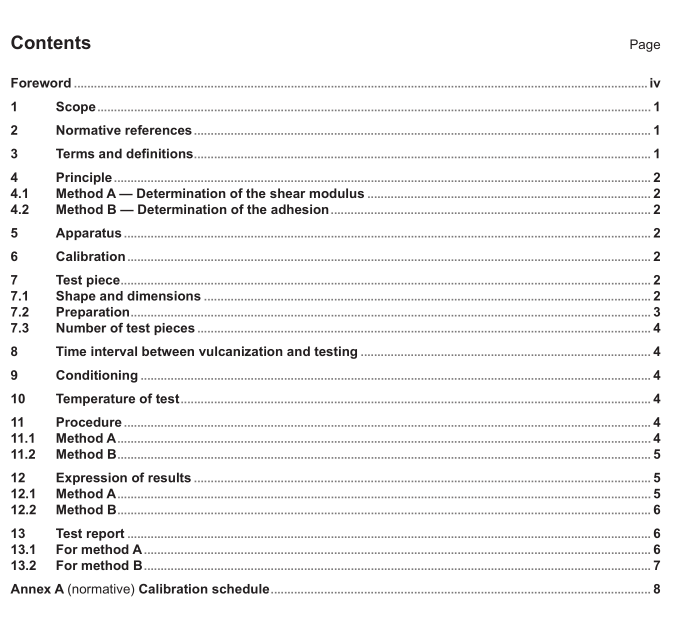ISO 1827 pdf download

ISO 1827 pdf download Rubber, vulcanized or thermoplastic — Determination of shear modulus and adhesion to rigid plates — Quadruple- shear methods
1 Scope
This International Standard specifies methods for the determination of the modulus in shear and the strengthof bonds of rubber to metal or other rigid plates, using rubber bonded between four parallel plates.
Method A describes the determination of the modulus in shear.
Method B describes the determination of the strength of the bonds.
The methods are applicable primarily to test pieces prepared in the laboratory under standard conditions,such as can be used to provide data for the development and control of rubber compounds and methods ofmanufacture of bonded shear units.
2Normative references
The following referenced documents are indispensable for the application of this document.For datedreferences, only the edition cited applies.For undated references, the latest edition of the referenced document(including any amendments) applies.
ISO 5893:2002,Rubber and plastics test equipment —Tensile, flexural and compression types (constant rateof traverse)-Specification
ISO 18899:2004,Rubber —Guide to the calibration of test equipment
ISO 23529,Rubber—General procedures for preparing and conditioning test pieces for physical test methods
3Terms and definitions
For the purposes of this document, the following terms and definitions apply.3.1
shear modulus
applied shear stress, calculated with respect to the bonded areas of the rubber in a test piece as specified inthis International Standard, divided by the resultant shear strain in the direction of application of the stressNOTE1 The shear strain() is half the measured deformation divided by the thickness of one rubber block or element.The shear stress () is the applied force divided by twice the area of a bonded face of one rubber block or element.
NOTE 2 The form of the test piece specified ensures that there is zero applied stress in the direction normal to thebonded surfaces,so that the deformation can be regarded as simple shear.
NOTE 3 This definition of shear modulus is sometimes referred to as the secant modulus.
4Principle
4.1Method A -Determination of the shear modulus
The force required to obtain a range of predetermined shear strains of a unit of standard dimensions comprisingfour parallelepipeds of rubber symmetrically disposed and bonded to four parallel rigid plates is measured,the forces being parallel to the bonding surfaces and, as a rule,non-destructive, i.e. of maximum valuesappreciably lower than the bond strength.
4.2Method B- Determination of the adhesion
The force required to cause the rupture of a unit as described for method A is measured.
5 Apparatus
5.1Test machine, complying with the requirements of lSo 5893,capable of measuring force with anaccuracy corresponding to class 1, as defined in ISo 5893:2002, and with a rate of traverse of the moving gripof 5 mm/min (method A) or 50 mm/min (method B).
The test machine shall include apparatus to measure the deformation of the rubber of the test piece to anaccuracy of 0,02 mm.
5.2Fixtures, for holding the test pieces in the grips, provided with a universal joint to permit accurate centringof the line of action of the applied force.
5.3 Environmental chamber,suitable for carrying out tests at the temperature chosen or specified(see Clause 10), conforming to the requirements of ISo 23529.
6 Calibration
The test apparatus shall be calibrated in accordance with the schedule given in Annex A.
7 Test piece
7.1Shape and dimensions
The test piece shall consist of four identical parallelepipedic rubber elements 4 mm±1 mm thick, 20 mm±5 mmwide and 25 mm ± 5 mm long, bonded on each of their two largest opposite faces to the mating faces of fourrigid plates of the same width and of appropriate lengths to obtain a symmetrical double-sandwich arrangement,means being provided at the free external end of each central plate to enable it to be attached to a holdingfixture. The rigid plates shall be of sufficient thickness to withstand bending. A typical arrangement is shownin Figure 1.









